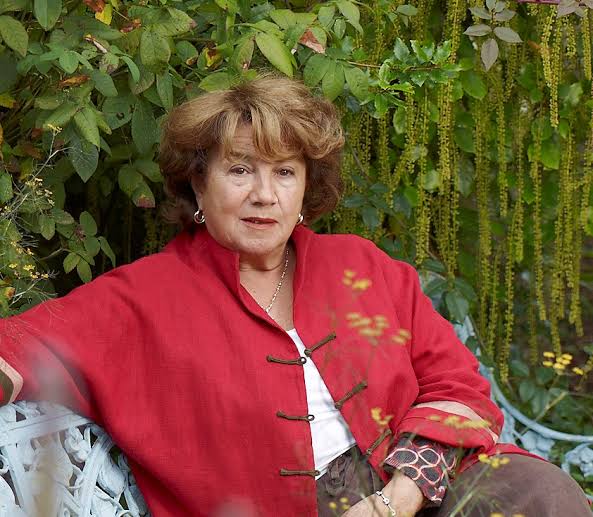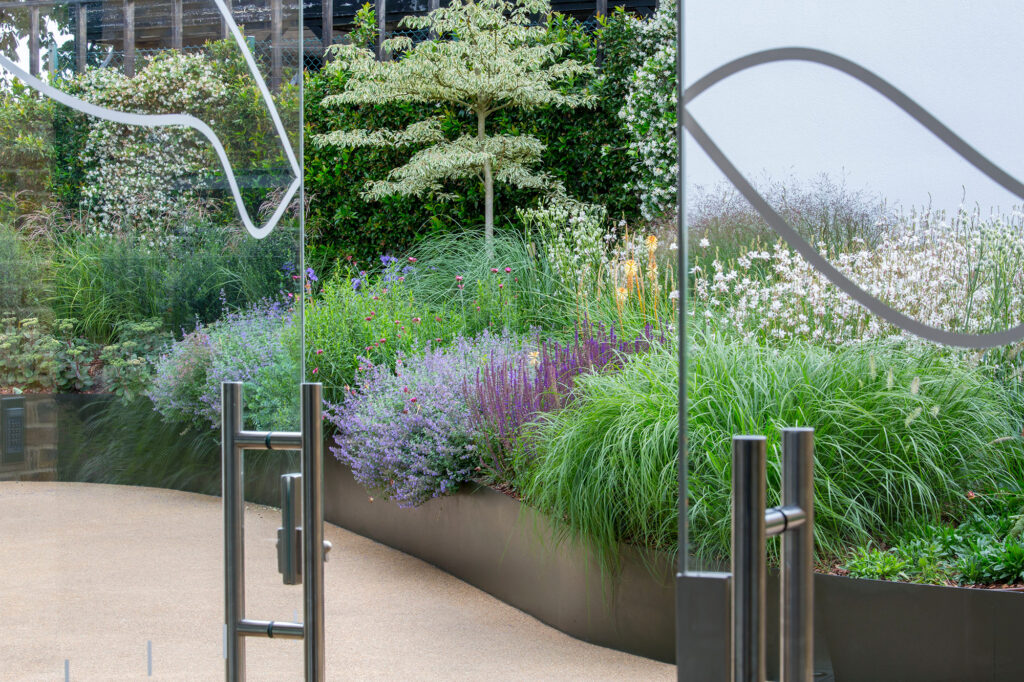I first experienced Arabella Lennox Boyd’s ideas about gardens when I borrowed her book Gardens in My Life from the Sturgeon Bay public library. At the time, I was just desperate for beautiful garden images; I don’t remember reading anything but the introduction. I wasn’t in it to learn, just to see. I don’t remember exactly when I first looked at Gresgarth Hall or the serpentine garden around the Sackler Gallery, but I remember looking through her gardens two or three times before I returned the book. I was just starting to paint again, so I did some watercolor studies of the simpler designs. At the time, I didn’t know I’d be starting a gardening podcast or exploring designers, and I certainly didn’t know she is one of the world’s best, at she is for me. I didn’t know how badly I needed a pragmatic romantic who loves Nature as much or more than me.


Arabella Lenux-Boyd was born in Italy but has lived most of her life in Britain. She was raised on a beautiful hillside estate outside of Rome, but her family was in a difficult financial state after World War 2, so the “gardens” were not really an important part of her upbringing. She asked to grow flowers once, but her mother told her they would not spend money or time on flowers, but olive trees which produce something to be sold. Fortunately for us, she spent most of her time in the most beautiful garden of all: “out of doors,” surrounded by the beauty and truth of Nature.
Now, she is known the world over as a masterful garden designer who has a profound connection to the rhythms of nature. She stands as a example for anyone who cherishes the romantic beauty and natural complexity of cultivated landscapes. She truly embraces some of the best ideas of Europe: the romance of an Italian childhood spent in blissful Nature and the cultivated structure of English gardens learned in London.
She left home to start her new life in England and was educated in landscape architecture at the Thames Polytechnic, now known as the University of Greenwich. Arabella’s design philosophy was nurtured under the guidance of mentors like Robert Cardozo, who emphasized the importance of using one’s senses and the power of observation to ‘carve’ rather than ‘design’ spaces out of the natural environment. This principle has guided her throughout an illustrious career, allowing her to create gardens that are not only visually stunning but deeply integrated with their natural surroundings.

Her work spans a wide range of projects, from the intimate gardens of private residences to impactful public spaces like the Serpentine Sackler Gallery, as well as personal commissions for notable figures such as Sting and Trudie Styler. Yet, regardless of scale or prominence, each project is imbued with Lennox-Boyd’s signature style: a celebration of herbaceous borders, a collector’s passion for plants and shrubs, and a meticulous attention to planting and landscaping that speaks both of artistic intent and ecological sensitivity.

At the heart of her design ethos is a belief succinctly captured in her own words: “One has to be in contact with nature; nature teaches you so much.” This philosophy reflects not only in her creative process but also in her approach to garden design as an ongoing dialogue with the natural world—a dialogue marked by patience, observation, and an unyielding commitment to beauty and sustainability.
Her personal journey from the olive groves of Italy to the prestigious gardens of Britain, and her transformative work on her own residence, Gresgarth Hall, encapsulate her evolution as a designer dedicated to creating spaces that resonate with both the aesthetic and functional demands of garden artistry. The gardens at Gresgarth Hall, in particular, serve as a living portfolio of her talent, showcasing a blend of wild and structured elements that invite both admiration and introspection.
Arabella’s designs, influenced by her Italian heritage and enriched by her travels—most notably to Japan, where she encountered a new dimension of precision and respect for subtlety in garden design—continue to evolve. Yet, they remain anchored in the principles that have defined her career: a reverence for nature, a meticulous eye for detail, and an unwavering belief in the power of gardens to inspire and transform.
In the world of garden design, Arabella Lennox-Boyd is not just a practitioner but a visionary, whose works remind us of the deep connections we share with the landscapes we inhabit. Her gardens are more than just spaces; they are narratives woven from the earth, teaching us so much if we are patient and observant. Through her enduring contributions, Arabella invites us all to see gardens not just as areas of beauty and refuge but as essential dialogues between humanity and the earth—a legacy that will continue to inspire and guide future generations of gardeners and designers alike. And no garden illustrates this more than Ninfa.
Forgive me if I digress for a moment. My wife, an amazing artist, loves Italy, having taught art there numerous times. And every time she returns, she describes how beautiful almost everything is in Rome and the surrounding countryside. She loves that Italians take the time to cultivate beauty in grand and small ways: On the way to an ancient church with a hidden fresco worth the rental car fee, one might stop at a roadside gas station that serves gelato and pizza, but everything arrives on ceramic plates with beautiful glasses that must be returned. I, on the other hand, would be happy to eat my pizza on a ceramic plate, a paper plate, or with my bare hands if we were on our way to see perhaps Arabella’s greatest accomplishment, the gardens of Ninfa.


Ninfa, nestled in the heart of Italy, just outside Rome, is said to be a Romantic symphony of natural beauty harmoniously intertwined with historical whispers and careful design principles. This botanical paradise, once a medieval town now reclaimed by nature, stands as a testament to the delicate dance between the past and the present, between Nature and artifice, where time itself seems to pause in reverence to its serene splendor. Once owned by aristocracy, it is now managed by the Roffredo Caetani Foundation, named after pernicious owner Marguerite Chapin’s aristocratic husband
As one steps into Ninfa, a tapestry of colors, textures, and scents invites you into a different reality. The garden is like a living painting, where each brushstroke is a flower in bloom, each hue more vibrant than the last, each branch an opportunity. From the delicate whispers of pink cherry blossoms to the rich blues of magnificent hydrangeas, the garden is a kaleidoscope of life, ever-changing with the seasons.
Water fuels the pulsating energy and vitality of Ninfa. Its crystal-clear streams and languid lakes reflect the azure skies above, creating a mirage of floating gardens. The gentle murmur of the Ninfa River weaves through the landscape, a serene melody of the natural beauty that unfolds around every corner. Ancient ruins, their stones softened by time, are draped in the lush embrace of climbing roses and ivy, blurring the lines between man-made and natural, creating a mosaic of history and nature. I can see it now… in the subtlety of my Imagination.
Pathways meander through the garden, inviting visitors on a journey through a living fairytale. Each turn reveals a new secret of Ninfa: a hidden alcove sheltered by towering cypresses, a sun-dappled glade that sparkles with the morning dew, or an ancient archway that frames the untamed beauty of the surrounding landscape.
Ninfa breathes the symphony of nature; the buzzing of bees, the soft flutter of butterfly wings, and the melodious songs of birds celebrate the joys of life. The garden, in its tranquil beauty, serves as a sanctuary not only for flora and fauna, but for the human soul, offering a place of peace and reflection, an honest view of another reality, a true glimpse of Nature.
In Ninfa, time stands still, allowing one to wander, to wonder, and to lose themselves in the beauty of a certain reality many of us might not really believe in anymore. It is a garden where history and Nature embrace, a place where the beauty of the earth is celebrated in every leaf, every stone, and every whispering breeze. Ninfa is not just a garden; it is a promise. I can see it now, in the subtlety of my imagination. I must see it this way because I’ve never been to Ninfa.
I, like so many people, know the gardens of Arabella Lennox-Boyd through the internet and books and other people’s words. When I first started this study, I wanted to know the artist, the designer, the person, in order to create a review, an episode, a digital artifact. Now, I want only to go to Ninfa. My wife has asked me for years to go to Italy with her. I didn’t want to go, so I made excuses: the cost, the time, work… As usual, she was right. In my research, I’ve read three time that Ninfa is the most Romantic garden in the world, where Nature is truly alive and celebrated. I have seen only the digital artifacts; I must see the real thing now; I must go there to feel the song for myself. I don’t know how long it will take, but when I get back, I’ll tell you the truth. I’ll share my reality.


